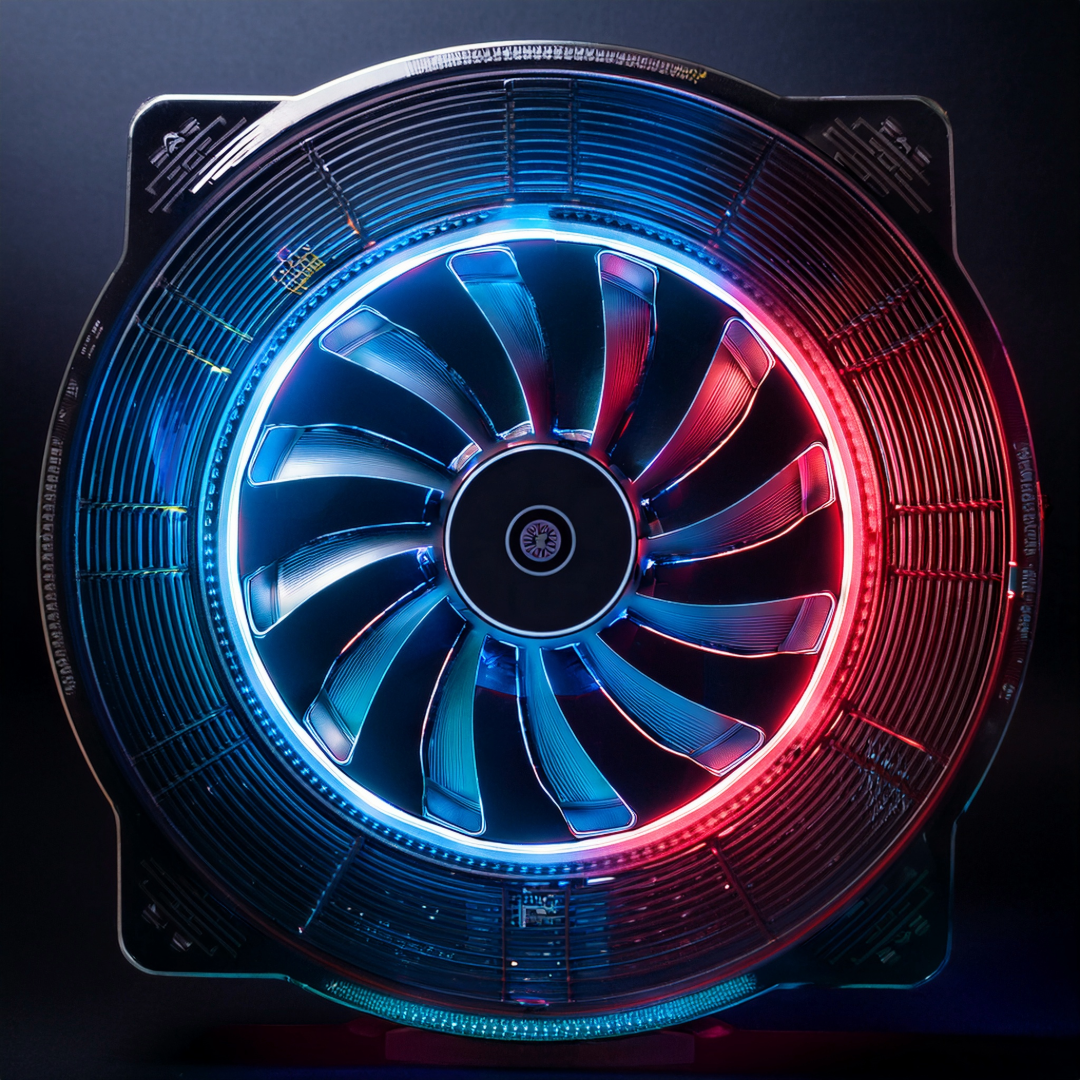AMD’s 2025 Power Play: Ryzen 9000 & Radeon RX 9000 Deep Dive for Gamers & Streamers
The PC hardware landscape in early 2025 is alive with the hum of new silicon, largely driven by AMD’s latest major product launches: the Zen 5-based Ryzen 9000 series CPUs and the RDNA 4-powered Radeon RX 9000 series GPUs. Arriving through staggered releases – the initial Ryzen 9000 desktop chips landed in August 2024 , followed by the gaming-focused X3D variants in Q1 2025 , and the Radeon RX 9000 GPUs making their debut in March 2025 – these components represent AMD’s bid to capture the hearts and wallets of PC builders, particularly gamers and streamers.
This analysis delves into the technical specifications, architectural advancements, real-world performance, platform requirements, and market positioning of AMD’s newest offerings. The goal is to provide a comprehensive evaluation for enthusiasts planning a new build or upgrade in 2025, focusing specifically on the implications for gaming and streaming PCs. We will dissect the Ryzen 9000 series, explore the Radeon RX 9000 lineup, examine platform synergies like PCIe 5.0 and DirectStorage, and conclude with build considerations and recommendations.
Section 1: Unpacking the Ryzen 9000 Series (Zen 5)
AMD’s Ryzen 9000 series marks the arrival of the much-anticipated Zen 5 microarchitecture on the desktop, promising improvements in performance and efficiency over the preceding Zen 4 generation.
Subsection 1.1: Zen 5 Architecture: What’s New for Performance?
Zen 5 represents a significant architectural redesign compared to Zen 4, aiming to boost performance across various workloads, including gaming and demanding streaming tasks. AMD officially claims an average Instructions Per Clock (IPC) uplift of approximately 16% for Zen 5 over Zen 4 in desktop workloads. IPC measures how much work a CPU core can do in each clock cycle; theoretically, a higher IPC should translate to better performance at the same clock speed. However, the real-world impact depends on how these architectural changes interact with specific applications.
Key architectural enhancements relevant to performance include :
- Improved Branch Prediction: Zen 5 features a redesigned branch predictor aimed at higher accuracy and lower latency. This is crucial for workloads with unpredictable instruction flow, such as gaming, potentially leading to faster response times and smoother gameplay. The predictor can now operate “two-ahead,” predicting up to two branches per cycle, a notable increase from previous Zen architectures. Enhanced data prefetching further assists this process.
- Wider Pipelines and Execution Units: The architecture boasts a wider front-end, doubling the instruction fetch/decode rate from 32 bytes/cycle to 64 bytes/cycle. Dispatch bandwidth increases from 6 to 8 macro-operations per cycle, and the number of Arithmetic Logic Units (ALUs) grows from 4 to 6 per core. These changes suggest higher throughput, beneficial for complex parallel tasks like video encoding, 3D rendering, and potentially future, more complex game engines.
- Cache Hierarchy Enhancements: Zen 5 brings several improvements to the cache system. The L1 data cache size per core increases from 32KB to 48KB, with associativity rising from 8-way to 12-way. Bandwidth between L1 and L2 caches is doubled, and the L2 cache, while remaining 1MB per core, sees its associativity double from 8-way to 16-way. L3 cache latency is also slightly reduced. Faster and larger caches are critical for reducing the time the CPU waits for data, which directly impacts gaming performance.
- AVX-512 Enhancements: Building on Zen 4’s introduction of AVX-512, Zen 5 expands capabilities with a doubled floating-point datapath width (native 512-bit on desktop/server variants) and adds support for VNNI instructions, beneficial for AI workloads. This enhances performance in AI-driven content creation tools, scientific simulations, and certain encoding tasks, potentially playing a role in future game physics or AI implementations.
- Process Node: The Core Complex Dies (CCDs) housing the Zen 5 cores are manufactured on TSMC’s N4P or N4X process (often referred to as 4nm), offering density and efficiency improvements over Zen 4’s N5 node. The I/O Die (IOD), handling memory control and PCIe lanes, appears largely unchanged from Ryzen 7000, remaining on TSMC’s N6 process.
- 2nd Generation 3D V-Cache: For the gaming-focused X3D models (Ryzen 9 9950X3D, Ryzen 9 9900X3D), AMD has refined its 3D V-Cache implementation. The extra L3 cache die (64MB) is now positioned underneath the main CPU cores (CCDs) rather than stacked on top. This relocation allows the heat-generating cores to be closer to the cooler, enabling higher sustained clock speeds and TDPs compared to the first-generation 7000X3D parts. This potentially reduces the performance trade-off in productivity tasks often seen with X3D chips. The 9950X3D features a total of 144MB cache, while the 9900X3D has 140MB.
Despite the significant architectural changes and the claimed 16% average IPC uplift, the real-world performance picture for the initial non-X3D Ryzen 9000 series is nuanced. While productivity benchmarks often show substantial gains over Zen 4, reflecting the benefits of increased throughput and improved AVX-512 , gaming performance improvements have been far more modest, frequently falling short of the average IPC gain and sometimes lagging behind Intel’s 14th Gen competitors or even the previous-gen Ryzen 7000X3D parts.
Several factors contribute to this. Firstly, many of the architectural enhancements, like wider pipelines and beefed-up AVX-512 units, inherently benefit highly parallelized, compute-heavy productivity tasks more directly than latency-sensitive gaming workloads. Secondly, the initial non-X3D Zen 5 SKUs launched with notably lower TDPs than their Zen 4 predecessors (e.g., Ryzen 7 9700X at 65W vs. Ryzen 7 7700X at 105W). While this leads to impressive efficiency gains , it can also limit sustained boost clocks in demanding gaming scenarios, potentially capping performance uplift. Early testing with Simultaneous Multithreading (SMT) disabled even showed potential performance gains in some games, hinting at scheduling complexities or opportunities.
Conversely, the Zen 5 X3D models (9950X3D, 9900X3D, and the heavily reviewed but not officially launched 9800X3D) demonstrate commanding leads in gaming benchmarks. These chips benefit from both the underlying Zen 5 IPC improvements and the massive L3 cache provided by 3D V-Cache, which directly tackles the memory latency bottlenecks prevalent in many games. The improved thermal design of the 2nd Gen V-Cache allows these chips to maintain higher clocks and TDPs, making them significantly more potent in productivity tasks than their 7000X3D predecessors.
This suggests a deliberate segmentation within the Ryzen 9000 series. The standard models prioritize efficiency and strong productivity gains, offering good-but-not-leading gaming performance. The X3D models, leveraging the refined V-Cache technology, are laser-focused on delivering absolute gaming dominance while now offering much more competitive productivity capabilities. For pure gamers, the X3D variants are the clear performance choice within the Zen 5 family.
Subsection 1.2: Meet the Lineup: Ryzen 9000 Specs
AMD has launched several SKUs within the Ryzen 9000 series, catering to different performance tiers and budgets. The table below outlines the key specifications for the desktop processors relevant to gamers and streamers as of April 2025:
Table 1: AMD Ryzen 9000 Series Desktop Specifications (April 2025)
| Model | Cores / Threads | Base Clock (GHz) | Boost Clock (GHz) | L2 Cache (MB) | L3 Cache (MB) | Total Cache (MB) | TDP (W) | MSRP (USD) |
|---|---|---|---|---|---|---|---|---|
| Ryzen 5 9600X | 6 / 12 | 3.9 | Up to 5.4 | 6 | 32 | 38 | 65 | $279 |
| Ryzen 7 9700X | 8 / 16 | 3.8 | Up to 5.5 | 8 | 32 | 40 | 65 | $359 |
| Ryzen 9 9900X | 12 / 24 | 4.4 | Up to 5.6 | 12 | 64 | 76 | 120 | $449 |
| Ryzen 9 9950X | 16 / 32 | 4.3 | Up to 5.7 | 16 | 64 | 80 | 170 | $599 |
| Ryzen 9 9900X3D | 12 / 24 | 4.4 | Up to 5.5 | 12 | 128 | 140 | 120 | $599 |
| Ryzen 9 9950X3D | 16 / 32 | 4.3 | Up to 5.7 | 16 | 128 | 144 | 170 | $699 |
Data Sources:
This table provides an at-a-glance comparison, allowing users to weigh core counts, clock speeds, cache amounts, power consumption, and price points when selecting a CPU.
All Ryzen 9000 desktop processors share common platform features, including the AM5 socket (LGA1718), support for DDR5 memory (officially up to 5600 MT/s JEDEC speeds), and 28 total PCIe 5.0 lanes (24 usable after chipset link), typically configured as x16 for the primary GPU slot and x4 for a primary NVMe SSD, with x4 remaining for the chipset link. They also include a basic integrated GPU based on the RDNA 2 architecture with 2 Compute Units, useful for troubleshooting or systems without a discrete graphics card.
Subsection 1.3: Performance Showdown: Gaming & Streaming Benchmarks
Independent reviews provide crucial context beyond specification sheets.
- Gaming Performance (Non-X3D): Reviews from outlets like Tom’s Hardware, Gamers Nexus, and Hardware Unboxed generally show that the standard Ryzen 9000 CPUs (9600X, 9700X, 9900X, 9950X) offer relatively modest gaming performance improvements over their direct Zen 4 predecessors, often in the range of 5-10% or less at 1080p. In many gaming benchmarks, they trail behind Intel’s 14th Gen Core i7 and i9 processors and are significantly outperformed by AMD’s own X3D variants (both 7000 and 9000 series). Some early reviews noted inconsistent performance or potential core parking issues, possibly related to immature BIOS versions or scheduling, although these seem largely resolved with subsequent updates. Testing with SMT disabled on the 9700X revealed potential performance gains in some titles, suggesting opportunities for better thread scheduling optimization.
- Gaming Performance (X3D): The Ryzen 9000X3D processors, particularly the Ryzen 7 9800X3D (based on extensive review coverage, though not officially listed in the provided launch materials) and the Ryzen 9 9950X3D, establish clear gaming leadership. Benchmarks show them significantly outpacing Intel’s fastest offerings, including the Core i9-14900K and the Core Ultra 9 285K, often by margins exceeding 20-30% in CPU-bound scenarios. The 9950X3D generally matches the 9800X3D in overall gaming performance, though individual game results can vary slightly due to the dual-CCD configuration of the 9950X3D. Improved chipset drivers help ensure gaming workloads are primarily directed to the cache-rich CCD.
- Productivity & Streaming Performance: This is where the standard Zen 5 chips shine. The Ryzen 9 9950X and 9900X demonstrate substantial multi-threaded performance gains compared to their Zen 4 counterparts and often outperform competing Intel chips in heavily threaded applications like rendering (Blender, Cinebench), video encoding (Handbrake), and compilation. This makes them excellent choices for content creators and streamers who frequently run demanding background tasks alongside gaming. The Zen 5 X3D models also show marked improvement in productivity compared to the 7000X3D series, thanks to the revised cache placement allowing for higher clocks and TDPs. The 16-core 9950X3D, in particular, offers a compelling blend of top-tier gaming and high-end productivity performance.
- Efficiency: A standout feature of the Zen 5 generation is its power efficiency. The 65W TDP Ryzen 7 9700X and Ryzen 5 9600X deliver performance remarkably close to the 105W/120W TDP Zen 4 7700X and 7600X while consuming significantly less power. Even the higher-TDP models like the 9900X and 9950X are considered efficient for the performance they deliver, especially in multi-threaded workloads. This reduced power draw translates to lower heat output, potentially simplifying cooling requirements and making these CPUs viable for a wider range of builds, including smaller form factors.
The performance data clearly illustrates a strategic split within the Ryzen 9000 series. The non-X3D models represent a significant step forward in multi-threaded productivity and power efficiency but offer only incremental gains in gaming over the previous generation. The X3D models, benefiting from both Zen 5’s IPC improvements and the latency-reducing effects of the large 3D V-Cache, decisively capture the gaming performance crown while also offering much stronger productivity performance than their predecessors due to the improved thermal design allowing higher clocks. This creates a clearer choice for consumers: X3D for ultimate gaming with strong productivity, or standard Zen 5 for top-tier productivity and efficiency with good gaming capabilities.
Subsection 1.4: The AM5 Platform Evolves: Chipsets, DDR5 & Compatibility
The Ryzen 9000 series continues AMD’s use of the AM5 socket platform, reinforcing the company’s commitment to platform longevity, with support pledged through 2027 and potentially beyond. This offers users a potential upgrade path for future CPU generations without requiring a motherboard replacement, a notable contrast to Intel’s more frequent platform changes.
Accompanying the Ryzen 9000 launch are new 800-series chipsets: X870E, X870, and the upcoming B850 and B840.
- Chipset Hierarchy & Features:
- X870E (Extreme): The top-tier chipset, utilizing two “Promontory 21” chips for maximum connectivity and features. Mandates PCIe 5.0 support for both the primary x16 GPU slot (or two x8 slots) and at least one M.2 NVMe slot. Also guarantees onboard USB 4.0 ports. Offers the highest number of chipset-provided PCIe lanes, USB ports (up to 12x 10Gbps, 2x 20Gbps), and SATA ports (up to 8). Supports CPU and memory overclocking.
- X870: A high-end chipset using a single Promontory 21 chip. Also mandates PCIe 5.0 for the GPU slot(s) and at least one NVMe slot, standard USB 4.0, and full overclocking support. Offers fewer connectivity options compared to X870E (e.g., up to 6x 10Gbps USB, 1x 20Gbps USB, 4x SATA).
- B850: Expected mid-range chipset (launching later in 2025). Likely to feature PCIe 5.0 support for at least one NVMe slot, but potentially PCIe 4.0 for the GPU slot. Will support memory overclocking (EXPO) and possibly CPU overclocking. USB 4.0 support might be optional rather than standard.
- B840: Expected entry-level chipset (launching later in 2025). Likely focused on PCIe 4.0 connectivity, potentially dropping PCIe 5.0 support altogether, but still supporting DDR5 memory overclocking.
- Motherboard Features: Boards based on these chipsets, particularly X870E/X870, often come equipped with robust Voltage Regulator Modules (VRMs) to handle high-end CPUs, WiFi 7 and multi-gigabit Ethernet for connectivity, improved audio codecs, and user-friendly features like enhanced M.2 Q-Latches and PCIe Slot Q-Release mechanisms.
- Backward Compatibility: Crucially, Ryzen 9000 processors are compatible with older AM5 motherboards (X670E, X670, B650E, B650, A620) provided the motherboard receives a BIOS update. This allows users to pair a new CPU with an existing, potentially cheaper, motherboard. However, older boards might lack guaranteed USB 4.0 support or the potentially more optimized memory trace layouts for extreme DDR5 overclocking found on some X870 boards.
- DDR5 Memory: Ryzen 9000 officially supports JEDEC DDR5-5600 speeds. For optimal performance, especially in gaming, overclocked memory using AMD EXPO profiles is recommended. The widely accepted “sweet spot” balancing performance, stability, and cost remains DDR5-6000 CL30, running in a 1:1 ratio with the CPU’s memory controller clock (UCLK) and Infinity Fabric clock (FCLK). While Zen 5’s memory controller shows potential for slightly higher 1:1 speeds, reaching DDR5-6400 CL32 stably depends heavily on the individual CPU’s Integrated Memory Controller (IMC) quality (a “silicon lottery”) and may require manual tuning or higher SoC voltage. X870 motherboards might offer slightly better signal integrity for achieving these higher speeds. Speeds beyond 6400 MT/s typically force the memory controller into a 2:1 ratio, which introduces significant latency penalties that often negate the bandwidth gains for gaming.
The introduction of the X870E and X870 chipsets brings the latest connectivity standards like mandatory USB 4.0 and widespread PCIe 5.0 support to the AM5 platform. However, these features contribute to the higher cost typically associated with flagship motherboards. Given that Ryzen 9000 CPUs work perfectly well in older, updated 600-series boards , builders face a cost-benefit decision. Many existing B650/X670 boards already offer the features most crucial for gamers and streamers, such as PCIe 4.0 (or even 5.0) slots for GPUs and NVMe drives, robust power delivery, and stable support for DDR5-6000 memory. The primary advantages of the new 800-series boards – guaranteed USB 4.0 and potentially better high-frequency RAM overclocking headroom – may not be essential for everyone. Since PCIe 5.0 for GPUs currently provides negligible gaming benefits , opting for a well-featured B650E or X670/E board with an updated BIOS can be a significantly more cost-effective way to build a Ryzen 9000 system without sacrificing meaningful performance.
Section 2: Diving into Radeon RX 9000 Series (RDNA 4)
Alongside the Zen 5 CPUs, AMD launched the Radeon RX 9000 series graphics cards, powered by the new RDNA 4 architecture. This generation marks a strategic shift, focusing on the high-volume mainstream and high-end market segments rather than competing directly with Nvidia’s most expensive halo products.
Subsection 2.1: RDNA 4 Architecture: Gaming, Ray Tracing, and AI Enhancements
RDNA 4 aims to deliver significant improvements in gaming performance, ray tracing capabilities, AI-driven features like upscaling, and media encoding efficiency.
Key architectural changes include:
- 4th Generation Compute Units: The fundamental building blocks of the GPU have been enhanced, with AMD claiming up to 40% higher gaming performance per CU compared to RDNA 3. This is achieved through a combination of higher clock speeds and architectural refinements like Dynamic Register Allocation (allowing shaders to use registers more flexibly, potentially improving utilization) and Out-of-Order Memory Execution (allowing memory requests to be processed more efficiently, reducing stalls, particularly beneficial for latency-sensitive tasks like ray tracing).
- 3rd Generation Ray Tracing Accelerators: This area sees a major overhaul aimed at closing the performance gap with Nvidia. RDNA 4 claims over 2x the ray tracing throughput per CU compared to RDNA 3. This is achieved through several enhancements: doubled ray intersection engines, improved BVH (Bounding Volume Hierarchy) compression, accelerated traversal and shading logic, dedicated hardware for instance transforms, and support for more efficient BVH8 structures and Oriented Bounding Boxes (OBB). OBB allows the bounding boxes used in RT calculations to better fit angled objects, reducing unnecessary intersection tests.
- 2nd Generation AI Accelerators: RDNA 4 significantly boosts AI capabilities with enhanced matrix cores. These accelerators now support new, efficient data types like FP8 (and potentially INT4/BF8/INT8 ) and structured sparsity, a technique that speeds up calculations by skipping zero-value multiplications. AMD claims up to 8x the INT8 throughput per accelerator (with sparsity) compared to RDNA 3. The RX 9070 XT boasts a peak of 1557 TOPS (INT4 sparse). These improvements are crucial for powering the new FSR 4 upscaling technology and other potential AI-accelerated features.
- FidelityFX Super Resolution 4 (FSR 4): A flagship feature of RDNA 4, FSR 4 represents a shift to Machine Learning (ML)/AI-based upscaling, similar to Nvidia’s DLSS. This is a significant departure from FSR 1/2/3, which used spatial and temporal algorithms. FSR 4 is exclusive to RDNA 4 hardware (RX 9000 series) due to its reliance on the new AI Accelerators. It promises substantial improvements in image quality over FSR 3.1, specifically targeting better temporal stability (less flickering/shimmering), improved detail preservation, and reduced ghosting artifacts. AMD announced support for over 30 games at launch, with many more planned.
- Enhanced Media Engine: RDNA 4 features an updated media engine, including dual hardware encoders on Navi 48. It offers improved encode and decode quality and performance/efficiency for modern codecs like AV1, HEVC (H.265), and H.264. This addresses a key weakness of previous Radeon generations, particularly the H.264 quality at lower bitrates often used for streaming , making RDNA 4 much more appealing for streamers and content creators. Improvements include better motion estimation and multi-frame reference capabilities, leading to cleaner output with fewer blocky artifacts.
- Radiance Display Engine: The display engine is updated to support the latest standards, including DisplayPort 2.1a (supporting UHBR13.5 for up to 54 Gbps bandwidth) and HDMI 2.1b. This enables support for future high-resolution, high-refresh-rate monitors (e.g., 4K @ 240Hz/480Hz, 8K @ 144Hz/165Hz) with 12-bit HDR. It also includes support for Hardware Flip Queue, potentially improving video playback smoothness and reducing CPU overhead.
- Process Node & Design: The Navi 48 GPU, powering the RX 9070 and 9070 XT, uses TSMC’s N4P process node. Unlike the high-end RDNA 3 chiplet design, Navi 48 returns to a monolithic die design.
The architectural direction of RDNA 4 reveals a strategic focus. Having lagged significantly behind Nvidia in ray tracing performance and AI-driven features like DLSS with RDNA 2 and 3, AMD clearly prioritized addressing these weaknesses. The substantial improvements to the RT accelerators and the introduction of powerful AI accelerators supporting modern data types and techniques (sparsity) are direct responses. The development of the ML-based FSR 4 is a crucial step towards achieving parity with DLSS in upscaling quality.
Simultaneously, AMD made the strategic decision to target the mainstream and high-end market segments ($500-$600 price bracket) with this generation, rather than pursuing an ultra-high-end halo product to compete with Nvidia’s flagship. Benchmark results reflect this strategy: RDNA 4 delivers massive generational leaps in ray tracing compared to RDNA 3 , and FSR 4 quality is vastly improved. The encoder enhancements are also significant for creators and streamers. However, in the most demanding path-traced scenarios, Nvidia’s RTX 50 series still holds an advantage , and the latest DLSS iterations might offer slightly better motion clarity.
RDNA 4, therefore, represents a “catch-up” architecture in key areas, making AMD GPUs far more well-rounded and competitive in features that modern gamers and streamers demand. By focusing these improvements on the higher-volume market segment and pricing aggressively, AMD aims to deliver strong value rather than chase the absolute performance crown this generation.
Subsection 2.2: Meet the Lineup: Radeon RX 9000 Specs
As of April 2025, AMD has officially launched two graphics cards based on the RDNA 4 architecture:
Table 2: AMD Radeon RX 9000 Series Specifications (April 2025)
| Model | Architecture (GPU) | CUs | Shaders (ALUs) | RT Cores | AI Cores | Game Clock (MHz) | Boost Clock (MHz) | Memory (Size GB) | Memory (Type) | Memory Speed (Gbps) | Memory Bus (bit) | Infinity Cache (MB) | TBP (W) | Launch Price (USD) |
|---|---|---|---|---|---|---|---|---|---|---|---|---|---|---|
| Radeon RX 9070 | RDNA 4 (Navi 48) | 56 | 3584 | 56 | 112 | 2070 | Up to 2520/2540* | 16 | GDDR6 | 20 | 256 | 64 | 220 | $549 |
| Radeon RX 9070 XT | RDNA 4 (Navi 48) | 64 | 4096 | 64 | 128 | 2400 | Up to 2970 | 16 | GDDR6 | 20 | 256 | 64 | 304 | $599 |
Note: Some sources list 2520 MHz boost , others list 2540 MHz. Game clocks also vary slightly between sources. Data Sources:
This table highlights the key differences between the two initial RDNA 4 offerings. The RX 9070 XT utilizes the fully enabled Navi 48 die, while the RX 9070 features a cut-down version with fewer CUs, RT cores, and AI cores, along with lower clock speeds and a significantly lower TBP. Both cards share the same 16GB GDDR6 memory configuration on a 256-bit bus with 64MB of Infinity Cache.
It’s important to note that AMD is not producing reference design cards for this generation. All Radeon RX 9000 series cards available at retail are designed and manufactured by Add-In Board (AIB) partners such as Sapphire, PowerColor, ASUS, Gigabyte, XFX, and ASRock. This leads to variations in cooler designs, physical dimensions, factory overclocks, and potentially power connector configurations. While most models adhere to the standard 2x 8-pin PCIe power connectors, some heavily overclocked RX 9070 XT variants might utilize three 8-pin connectors or, less commonly for AMD, the 12V-2×6 connector.
Subsection 2.3: Performance Showdown: Gaming, Ray Tracing & Streaming Benchmarks
Independent benchmarks paint a compelling picture for the RX 9000 series, particularly in traditional rasterization performance and value.
- Rasterization Performance: The Radeon RX 9070 XT ($599) consistently performs at or above the level of the more expensive Nvidia GeForce RTX 5070 Ti ($749) in non-ray-traced games across various resolutions (1080p, 1440p, 4K). It represents a significant uplift compared to previous AMD generations, often matching or exceeding the performance of the last-gen flagship RX 7900 XTX in rasterization and delivering substantial gains over cards like the RX 7900 XT/GRE (e.g., ~42% faster than 7900 GRE at 4K). The Radeon RX 9070 ($549) generally outperforms the similarly priced Nvidia GeForce RTX 5070 ($549) in rasterization and shows a solid improvement over the RX 7900 GRE. Specific game performance varies, with titles like Dragon’s Dogma 2 and Red Dead Redemption 2 showing strong results for AMD, while others like Final Fantasy XIV might favor Nvidia.
- Ray Tracing Performance: RDNA 4 marks a major step forward for AMD in ray tracing. The RX 9070 XT often delivers playable frame rates with RT enabled at 1440p and even 4K, especially when combined with FSR 4. The performance uplift over RDNA 3 is substantial, sometimes exceeding 50-60% in RT-heavy titles compared to the RX 7900 XTX. However, despite these significant gains, Nvidia’s RTX 50 series generally maintains leadership in the most demanding ray tracing and path tracing workloads (like Cyberpunk 2077 with RT Overdrive or Alan Wake 2 with path tracing). The gap has narrowed considerably compared to the RDNA 3 generation, but Nvidia’s dedicated RT hardware and software optimizations still provide an edge in these specific scenarios. Benchmarks like 3DMark Speed Way show improvement but still a deficit, while the less RT-intensive Steel Nomad shows competitiveness.
- FSR 4 Performance & Quality: FSR 4 delivers on its promise of significantly improved image quality compared to FSR 3.1, effectively addressing common complaints about temporal instability, ghosting, and detail loss. Quality comparisons often place it on par with or better than older DLSS versions (like DLSS 3.7 CNN-based). While Nvidia’s latest DLSS 4 (Transformer model) might still hold an edge in motion clarity , FSR 4 represents a massive leap, making AMD’s upscaling solution highly competitive. Performance-wise, FSR 4 might incur a slightly higher frame rate cost than FSR 3.1 due to the ML workload, but the goal is superior visual fidelity at comparable performance levels. Its exclusivity to RDNA 4 hardware is a key factor.
- Streaming/Encoding Performance: The enhanced media engine in RDNA 4 delivers notable improvements in video encoding quality, particularly for H.264 (crucial for platforms like Twitch) and HEVC, alongside strong AV1 capabilities. Reviews and analyses suggest AMD has largely closed the quality gap with Nvidia’s NVENC encoder, making Radeon cards a much more viable option for high-quality game streaming. The AV1 encoder, already competitive in RDNA 3 , likely sees further refinement, offering excellent quality for recording or streaming to platforms that support it (like YouTube).
The performance profile of the RX 9000 series highlights AMD’s value strategy. By delivering rasterization performance that rivals or exceeds Nvidia’s more expensive offerings (RTX 5070 Ti vs RX 9070 XT) , AMD provides compelling performance-per-dollar. Furthermore, offering 16GB of VRAM on both the $599 RX 9070 XT and the $549 RX 9070 provides a significant advantage over the $549 RTX 5070’s 12GB , which could be a limiting factor in future titles at higher resolutions or settings. While the vastly improved ray tracing and the introduction of the high-quality FSR 4 upscaler make RDNA 4 a much more complete package than its predecessors, these features serve more to bring AMD towards parity rather than establishing clear leadership over Nvidia’s DLSS and RT performance. Therefore, the core value proposition for the RX 9000 series rests heavily on its excellent rasterization performance for the price and its generous VRAM allocation, making it particularly attractive for gamers prioritizing traditional performance metrics and future-proofing. The improved encoder quality is a major bonus for streamers.
Subsection 2.4: System Integration: Power Needs, Cooling, and Case Fit
Integrating a new Radeon RX 9000 series GPU requires attention to power, cooling, and physical compatibility.
- Power Requirements:
- The Radeon RX 9070 XT has a Total Board Power (TBP) of 304W. AMD recommends a minimum 750W power supply unit (PSU) for systems using this card. Note that some heavily factory-overclocked partner models, like the PowerColor Red Devil, may recommend a higher wattage PSU (e.g., 900W) due to increased power draw.
- The Radeon RX 9070 has a lower TBP of 220W. The recommended minimum PSU wattage for this card is 650W.
- Most partner cards for both models utilize two standard 8-pin PCIe power connectors. Some high-performance RX 9070 XT variants might require three 8-pin connectors. Users should always check the specific requirements of the AIB card model they purchase. The reliance on standard 8-pin connectors avoids the need for the newer 12V-2×6 (12VHPWR) cable and associated ATX 3.0/3.1 PSUs, although some partner cards might adopt it.
- Cooling and Thermals: While RDNA 4 aims for improved efficiency , the RX 9070 XT (304W TBP) and RX 9070 (220W TBP) are still powerful GPUs that generate significant heat. Effective cooling is essential for maintaining boost clocks and performance. Partner cards universally feature substantial cooling solutions, typically with large heatsinks and multiple fans (often three). Good overall case airflow is crucial to help dissipate the heat generated by the GPU.
- Physical Dimensions and Case Compatibility: As all RX 9000 series cards are partner designs, physical dimensions vary considerably between models.
- Length: RX 9070 XT cards can range from relatively compact (e.g., PowerColor Reaper at ~289mm ) to very long (e.g., XFX Mercury at 360mm ).
- Width (Slot Count): Most cards occupy 2.5 to 3+ PCIe slots, meaning they are quite thick. The PowerColor Reaper is noted as being closer to 2 slots.
- Height: Card height (from the PCIe connector to the top edge) can also vary and might interfere with side panels or coolers in some cases, especially Small Form Factor (SFF) builds.
- Recommendation: It is imperative for builders to carefully check the maximum GPU length, width (slot count), and height clearances supported by their chosen PC case and compare these against the exact dimensions of the specific AIB partner card they plan to purchase. SFF builders need to be particularly diligent.
- PCIe Interface: The Radeon RX 9000 series utilizes a PCIe 5.0 x16 interface. However, as established, running these GPUs in a PCIe 4.0 x16 slot results in negligible performance loss in current games. The cards are fully backward compatible with PCIe 4.0 and even PCIe 3.0 slots, though performance will be limited by the slot’s bandwidth in the latter case.
Section 3: Platform Synergies for Modern Rigs
Beyond the individual performance of the CPU and GPU, modern PC platforms involve interplay between components and technologies like PCIe 5.0 and DirectStorage, impacting the overall user experience, especially for gaming and streaming.
Subsection 3.1: The PCIe 5.0 Factor: Does it Matter for Gaming/Streaming Yet?
The arrival of Ryzen 9000 and Radeon RX 9000 brings PCIe 5.0 support across both CPU and GPU components on the latest AM5 platforms. But does this faster interface translate to tangible benefits for gamers and streamers in April 2025?
- GPU Interface (PCIe 5.0 x16): Both Radeon RX 9000 and Nvidia’s competing RTX 50 series cards feature a PCIe 5.0 x16 interface. However, extensive testing across multiple generations and GPU tiers, including the powerful RTX 5090, consistently demonstrates that the performance difference between running a high-end GPU in a PCIe 5.0 x16 slot versus a PCIe 4.0 x16 slot is minimal, typically within a 1-4% margin, which is often indistinguishable in real-world gameplay. Even comparing PCIe 5.0 x16 to PCIe 3.0 x16 shows surprisingly small deficits in most gaming scenarios. This indicates that the bandwidth provided by PCIe 4.0 x16 (32 GB/s) is still largely sufficient for current gaming demands, and the doubled bandwidth of PCIe 5.0 x16 (64 GB/s) is not yet a limiting factor. Therefore, while having a PCIe 5.0 capable motherboard and CPU offers future-proofing, it provides no significant gaming performance advantage for GPUs like the RX 9070 XT today. A PCIe 4.0 x16 slot is perfectly adequate.
- NVMe SSD Interface (PCIe 5.0 x4): The situation with storage is different, at least on paper. PCIe 5.0 NVMe SSDs boast sequential read and write speeds that dwarf previous generations, reaching 10,000 MB/s to over 14,000 MB/s. This is roughly double the theoretical maximum of PCIe 4.0 SSDs (~7,500 MB/s) and quadruple that of PCIe 3.0 SSDs (~3,500 MB/s). However, translating these impressive sequential numbers into real-world gaming benefits has proven challenging. Numerous tests comparing game loading times across PCIe 5.0, 4.0, 3.0, and even high-quality SATA SSDs often show minimal, sometimes imperceptible, differences. This is partly because game loading involves accessing many small files, where random read/write performance (IOPS) is often more critical than raw sequential speed, and the IOPS gains with Gen 5, while present, are less dramatic than the sequential improvements. Furthermore, current storage APIs and game engines are not yet optimized to fully saturate the bandwidth offered by even PCIe 4.0 drives, let alone PCIe 5.0.
- PCIe 5.0 SSD Drawbacks: Beyond the limited practical gaming benefits, PCIe 5.0 SSDs come with significant downsides. They command a substantial price premium over equally capacious PCIe 4.0 drives. They also generate considerably more heat, necessitating robust passive heatsinks or even active cooling solutions (fans) to prevent thermal throttling or, in early models, outright shutdowns under sustained load. This increased heat is linked to higher power consumption compared to Gen 4 drives. While newer controllers like the Phison E31T and Silicon Motion SM2508 show improvements in efficiency , the fastest drives based on controllers like the Phison E26 or InnoGrit IG5666 remain power-hungry and hot-running.
The primary technology expected to unlock the potential of fast NVMe drives, particularly for gaming, is Microsoft’s DirectStorage API. However, its adoption has been slow, and early implementations haven’t shown significant differentiation based on PCIe generation.
Considering these factors, PCIe 5.0 SSDs appear to be overkill for the vast majority of gaming and streaming builds in April 2025. The substantial cost, heat, and power drawbacks are not currently justified by tangible performance benefits in these use cases. The underlying software and game engine optimizations needed to leverage their speed are still lagging. Therefore, high-quality PCIe 4.0 NVMe SSDs, such as the WD Black SN850X or Samsung 990 Pro, offer the best combination of excellent performance, reasonable cost, and manageable thermals for current builds. PCIe 5.0 SSDs remain an enthusiast product for those prioritizing maximum sequential throughput for specific productivity tasks or extreme future-proofing.
Subsection 3.2: Unlocking Speed with DirectStorage: Potential and Reality
Microsoft DirectStorage is a key API designed to modernize storage access for PC games, aiming to harness the speed of modern NVMe SSDs and alleviate CPU bottlenecks that hinder loading times and asset streaming.
- How it Works: DirectStorage allows games to issue multiple I/O requests to an NVMe drive concurrently, bypassing some traditional operating system overhead. It enables assets to be loaded more efficiently, potentially directly to the GPU’s VRAM, and can leverage the GPU for decompression tasks (using DirectStorage 1.1+ features like GDeflate). This reduces CPU load and allows the high bandwidth of NVMe drives to be better utilized, especially for the numerous small file reads common in game asset streaming.
- Requirements: The API works on Windows 10 and Windows 11, though Windows 11 includes further storage stack optimizations and is generally recommended. An NVMe SSD (PCIe 3.0 or faster) is required to see significant benefits, and a DirectX 12 capable GPU (Shader Model 6.0+) is also necessary.
- The Potential: The promise of DirectStorage is significant: drastically reduced loading times (potentially from tens of seconds to just one or two ), smoother streaming of assets in open-world games (eliminating pop-in or noticeable loading zones), more detailed game environments, and freeing up CPU resources for other tasks like physics or AI. Faster SSDs (PCIe 4.0 and especially 5.0) are expected to show greater benefits as games become more demanding and fully utilize the API’s capabilities. Some SSDs even feature “DirectStorage-optimized firmware”.
- The Reality (Adoption & Performance): Despite its potential and availability since March 2022 , developer adoption of DirectStorage has been remarkably slow. As of April 2025, only a handful of released titles actively use the API, including Forspoken (the first title ), Ratchet & Clank: Rift Apart, Horizon Forbidden West, and Forza Motorsport. Some upcoming titles listed on platforms like SteamDB also indicate DirectStorage support. Reasons cited for the slow uptake include perceived platform requirements, development complexity, or simply waiting for broader hardware adoption. Early benchmarks, such as those for Forspoken, showed surprisingly little difference in loading times between PCIe 3.0, 4.0, and 5.0 SSDs. This could be due to the specific implementation in that game, potential bottlenecks elsewhere (like CPU decompression if GPU decompression wasn’t used), or the game simply not stressing the storage subsystem enough to reveal significant differences. More titles and more mature implementations are needed to fully assess the real-world performance impact and the benefit of faster SSDs.
DirectStorage undoubtedly holds the key to unlocking the next level of game loading performance and world design by fully leveraging the speed of modern NVMe storage. However, its practical impact remains limited by the slow pace of developer adoption. While the underlying technology is sound and the hardware support is widespread in modern gaming PCs, the small number of games utilizing the API means its benefits are largely unrealized for the average gamer in early 2025. Therefore, while DirectStorage is a crucial technology for the future, builders should view it as a potential future enhancement rather than a primary reason to invest in the absolute fastest (and most expensive) PCIe 5.0 storage today. A reliable PCIe 4.0 NVMe SSD provides ample performance for current DirectStorage titles and general gaming needs.
Subsection 3.3: Boosting Your Stream: Encoding and AI Features
For streamers, a PC must simultaneously handle demanding gameplay and high-quality video encoding without compromising either. Both the Ryzen 9000 CPUs and Radeon RX 9000 GPUs bring features relevant to this workload.
- GPU Encoding (AMD Media Framework – AMF): Hardware video encoders built into modern GPUs (like AMD’s VCE/VCN, accessed via AMF) are essential for streamers, as they offload the computationally intensive task of encoding the video stream from the CPU, preserving gaming performance. The quality and efficiency of this hardware encoder are paramount.
- RDNA 4 Encoder Improvements: The Radeon RX 9000 series features an enhanced media engine. A significant focus has been placed on improving encode quality for AV1, HEVC (H.265), and particularly H.264 codecs compared to previous AMD generations. RDNA 2 and 3 sometimes faced criticism for H.264 quality lagging behind Nvidia’s NVENC, especially at the lower bitrates common on platforms like Twitch. RDNA 4 aims to rectify this, offering cleaner output with fewer compression artifacts. Reviews and analysis suggest these improvements largely succeed in bringing AMD’s encoder quality much closer to, or on par with, Nvidia’s offerings. The improved AV1 encoder is also beneficial for high-quality recordings or streaming to platforms like YouTube that support it. The Navi 48 chip also includes dual encoders, which could potentially be leveraged for higher quality or performance in future software implementations.
- CPU Role in Streaming: While the GPU handles the heavy lifting of encoding, a powerful CPU remains vital. The CPU manages the game itself, runs the streaming software (like OBS or Streamlabs), composites scenes, handles overlays, alerts, chat interactions, and other background applications. The strong multi-core performance and improved efficiency of the Ryzen 9000 series, especially the Ryzen 9 models, are well-suited for these demanding multitasking scenarios, ensuring smooth stream output without sacrificing in-game frame rates. The efficiency gains also help manage system heat and power draw during long streaming sessions.
- AI Features for Streamers: Both AMD CPU and GPU lines are incorporating AI capabilities. While Ryzen AI NPUs are primarily featured in mobile APUs , the AI Accelerators within the RDNA 4 GPUs and the AVX-512 capabilities of Zen 5 CPUs could power AI-driven features beneficial to streamers. Examples include AI-based noise suppression (like AMD Noise Suppression ), virtual backgrounds, webcam quality enhancement, or future AI tools integrated into streaming software. FSR 4 upscaling can also improve the visual quality of the game as seen by the streamer.
The combination of RDNA 4 and Zen 5 presents a significantly more compelling platform for streamers compared to previous AMD generations. The crux of this improvement lies in the synergy between the CPU’s robust multi-tasking capabilities and the GPU’s vastly improved encoding quality. Historically, streamers prioritizing stream quality often leaned towards Nvidia due to NVENC’s perceived superiority, particularly for H.264. RDNA 4’s enhanced media engine appears to largely neutralize this disadvantage, offering competitive encode quality across relevant codecs. Paired with Zen 5’s excellent multi-threaded performance for handling the game and streaming software concurrently , and its notable power efficiency for managing thermals during extended use , the Ryzen 9000 / Radeon RX 9000 combination becomes a potent and viable option for streamers seeking an all-AMD solution in 2025.
Section 4: Building Your 2025 Gaming/Streaming PC with AMD
With the technical details and performance characteristics explored, let’s consider the practical implications for building a gaming or streaming PC using AMD’s latest hardware in April 2025.
Subsection 4.1: Performance Gains: What to Expect Over Older Hardware
Upgrading to Ryzen 9000 and Radeon RX 9000 can offer substantial performance improvements depending on the starting point.
- CPU Upgrade:
- From Zen 3 (Ryzen 5000) or older / Intel 11th Gen or older: Users upgrading from these platforms will experience significant performance gains across the board. Zen 5 offers much higher IPC, more cores (in many cases), DDR5 memory support, and PCIe 5.0 capabilities. Gaming performance, especially with a 9000X3D CPU, will be dramatically improved. Productivity and streaming workloads will benefit immensely from the increased core counts and architectural efficiency. For example, the Ryzen 9 9950X shows roughly 1.87x the multi-threaded performance of the Ryzen 9 5950X.
- From Zen 4 (Ryzen 7000) / Intel 12th/13th/14th Gen: The upgrade path here is more nuanced. For gaming, moving from a standard Zen 4 or recent Intel chip to a standard Zen 5 chip (non-X3D) will likely yield only modest FPS gains. However, upgrading to a Zen 5 X3D model (9800X3D, 9950X3D) can provide a very significant gaming boost, even over a 7800X3D or 14900K. For productivity, standard Zen 5 offers noticeable multi-threaded performance and efficiency gains over Zen 4 , making it a worthwhile upgrade for content creators or heavy multitaskers.
- GPU Upgrade:
- From RDNA 2 (RX 6000) or older / Nvidia RTX 20/30 Series: Upgrading to a Radeon RX 9070 or 9070 XT will deliver substantial improvements in rasterization performance, enabling higher resolutions and settings. Ray tracing performance will see a massive jump, making RT features viable in many more titles. Users will also gain access to FSR 4 upscaling for improved image quality and the significantly enhanced RDNA 4 media encoder for better streaming/recording quality. For instance, the RX 9070 XT is benchmarked as being over 50% faster than the RX 6900 XT at 4K.
- From RDNA 3 (RX 7000) / Nvidia RTX 40 Series (non-flagship): The upgrade value depends on the specific starting card. Moving from a mid-range RDNA 3 card (like RX 7700 XT/7800 XT) to an RX 9070/9070 XT will offer solid rasterization gains and significantly better RT performance and FSR 4 quality. Upgrading from a higher-end RDNA 3 card like the RX 7900 XT/XTX might yield less dramatic rasterization improvements (the 9070 XT roughly matches the 7900 XTX in raster ) but still provides much better RT capabilities and FSR 4. Similarly, moving from an RTX 4070/4070 Ti to an RX 9070/9070 XT offers competitive performance, often better rasterization, more VRAM (vs 4070/5070), but potentially slightly weaker RT/upscaling.
Subsection 4.2: Value & Cost Analysis: Price vs. Performance vs. Competitors
Evaluating the value proposition requires comparing performance against cost for CPUs, GPUs, and the overall platform.
- CPU Value:
- Ryzen 9000 Standard: Launched at MSRPs generally lower than their Zen 4 predecessors ($599 for 9950X vs $699 for 7950X; $279 for 9600X vs $299 for 7600X). They offer strong productivity performance per dollar, especially considering their efficiency. However, their gaming performance value is less compelling compared to X3D chips or even discounted Intel 14th Gen parts. The 9700X ($359) and 9600X ($279) represent good efficiency-focused options.
- Ryzen 9000 X3D: The 9950X3D ($699) and 9900X3D ($599) carry premium price tags, similar to their 7000X3D counterparts at launch. While expensive, their chart-topping gaming performance arguably justifies the cost for enthusiasts seeking the absolute best. The (unofficial) Ryzen 7 9800X3D, often reviewed around a potential $480 price point, is frequently cited as offering the best high-end gaming value, balancing performance close to the 9950X3D with a lower cost.
- GPU Value:
- The Radeon RX 9070 XT ($599) emerges as a strong value contender. It delivers rasterization performance often matching or exceeding the $749 Nvidia RTX 5070 Ti , making its performance-per-dollar in traditional gaming very attractive.
- The Radeon RX 9070 ($549) directly competes with the Nvidia RTX 5070 ($549). It generally offers superior rasterization performance and boasts 16GB of VRAM compared to the RTX 5070’s 12GB. This makes it a compelling alternative, especially for those concerned about future VRAM limitations.
- Caveats: While AMD wins on rasterization value and VRAM (vs. 5070), Nvidia maintains an edge in peak ray tracing performance and potentially DLSS quality/adoption. Furthermore, launch availability and actual street prices heavily influence real-world value. Early reports suggest high demand and potential price inflation, similar to previous GPU launches.
- Platform Costs: Building an AM5 system requires DDR5 memory, which is now more affordable but still generally pricier than DDR4. Motherboard costs vary significantly. While new X870E/X870 boards are premium-priced , the ability to use Ryzen 9000 on cheaper, BIOS-updated B650 or X670 boards offers significant potential savings. The long-term value of the AM5 platform, with its promised longevity until 2027+, is a key advantage over Intel’s platforms which typically see shorter socket lifecycles.
AMD’s aggressive pricing in the $500-$600 GPU segment with the RX 9070 XT and RX 9070 puts significant pressure on Nvidia’s competing RTX 5070 Ti and 5070. By offering comparable or better rasterization performance at lower (or matched) prices, and providing more VRAM than the RTX 5070, AMD forces potential buyers to weigh the cost premium for Nvidia’s advantages in ray tracing and the DLSS ecosystem. If AMD and its partners can maintain stock near MSRP, the RX 9000 series represents excellent value for gamers prioritizing traditional performance and VRAM capacity.
Subsection 4.3: Essential Considerations: Power, Cooling, and Compatibility Checks
Before purchasing, ensure system compatibility and adequate supporting components.
- Power Supply: Select a high-quality PSU meeting or exceeding the recommended wattage: 650W+ for RX 9070, 750W+ for RX 9070 XT. Factor in the CPU’s TDP (up to 170W for 9950X/X3D) and other components. Check the specific power connector requirements for the chosen AIB GPU model (likely 2x 8-pin, potentially 3x 8-pin for OC 9070 XT).
- Cooling:
- CPU: While Zen 5 is efficient, the high-TDP Ryzen 9 9950X and 9950X3D (170W) require robust cooling. A high-quality air cooler or a 240mm/280mm (or larger) AIO liquid cooler is recommended for optimal performance, especially if enabling PBO or manual overclocking. The 120W TDP 9900X/X3D also benefits from strong cooling. The 65W TDP 9700X/9600X are much easier to cool and can work well with mid-range air coolers.
- GPU: Radeon RX 9000 cards, especially the 304W TBP RX 9070 XT, dissipate significant heat. Ensure the PC case has good airflow (multiple intake and exhaust fans). Partner cards come with substantial coolers, but adequate case ventilation is crucial to prevent thermal throttling.
- Case Compatibility: Physical GPU dimensions are critical. Verify the maximum GPU length, width (slot count), and height supported by the case against the specific dimensions of the chosen RX 9070/XT partner card model. Lengths vary widely (e.g., 288mm to 360mm+), and most cards are thick (2.5-3+ slots).
- BIOS Updates: If pairing a Ryzen 9000 CPU with an existing 600-series AM5 motherboard (X670E/X670/B650E/B650/A620), a BIOS update is mandatory for compatibility. Download the latest BIOS from the motherboard manufacturer’s website and update before installing the new CPU (often possible using BIOS Flashback features even without an older compatible CPU installed).
Subsection 4.4: Recommendations: Tailored Advice for Gamers and Streamers
Based on the analysis, here are some tailored build recommendations using AMD’s 2025 hardware:
- Pure High-FPS Gaming Build:
- CPU: AMD Ryzen 7 9800X3D (if available and priced competitively) or Ryzen 9 9950X3D. These offer the best gaming performance available.
- GPU: AMD Radeon RX 9070 XT. Provides excellent rasterization performance competitive with higher-priced rivals, much-improved RT, and 16GB VRAM.
- RAM: 32GB (2x16GB) DDR5-6000 CL30 EXPO kit.
- Motherboard: B650E or X670E (with updated BIOS) offers great value. X870E for the absolute latest features if budget allows.
- Storage: 1TB or 2TB PCIe 4.0 NVMe SSD (e.g., WD SN850X, Samsung 990 Pro).
- High-Quality Streaming + Gaming Build:
- CPU: AMD Ryzen 9 9950X or Ryzen 9 9950X3D. Both offer excellent multi-core performance for handling gaming, encoding, and background tasks. The 9950X3D provides better gaming, while the 9950X might edge it slightly in pure productivity for less cost.
- GPU: AMD Radeon RX 9070 XT. Delivers high frame rates for the streamer and high-quality encoding via the improved RDNA 4 media engine.
- RAM: 32GB (or 64GB for heavy video editing) DDR5-6000 CL30 EXPO kit.
- Motherboard: X870 or X870E recommended for better connectivity and potentially more robust power delivery for the high-end CPU. A high-end X670E with updated BIOS is also a strong option.
- Storage: 2TB+ PCIe 4.0 NVMe SSD. Consider a secondary drive for recordings/assets.
- Mid-Range Balanced Build:
- CPU: AMD Ryzen 7 9700X. Offers great 8-core performance with excellent efficiency (65W TDP).
- GPU: AMD Radeon RX 9070. Strong 1440p/4K rasterization performance, good RT capabilities, 16GB VRAM, and efficient encoder at a competitive price.
- RAM: 32GB (2x16GB) DDR5-6000 CL30 EXPO kit.
- Motherboard: B650 (with updated BIOS) or B850 (when available) provides sufficient features and value.
- Storage: 1TB or 2TB PCIe 4.0 NVMe SSD.
- Upgrade Considerations:
- From AM4 (Ryzen 5000/3000): Moving to AM5 with any Ryzen 9000 CPU will provide substantial platform benefits (DDR5, PCIe 5.0) and performance uplift. For gamers, targeting a 9000X3D CPU makes the most sense for a significant leap over even the 5800X3D.
- From Older Intel (11th Gen or earlier): Similar to AM4, the jump to Ryzen 9000 offers large performance and platform advantages.
- From AM5 (Ryzen 7000) / Newer Intel (12th-14th Gen): CPU upgrades are most compelling for gamers moving to an X3D model or for productivity users seeking the multi-threaded power and efficiency of the standard Ryzen 9 9950X/9900X. GPU upgrades depend heavily on the existing card, but moving to RX 9000 offers significant RT, FSR 4, and encoder improvements over RDNA 2/3.
Conclusion
AMD’s launch of the Ryzen 9000 series CPUs and Radeon RX 9000 series GPUs marks a significant push in the desktop PC market for 2025. The Zen 5 architecture underpinning the Ryzen 9000 series delivers impressive multi-threaded performance and notable efficiency gains, particularly appealing for productivity tasks and content creation. While the standard Zen 5 chips offer only modest gaming uplift compared to their predecessors, the refined 2nd Generation 3D V-Cache technology in the X3D variants propels AMD to undisputed gaming performance leadership, significantly outpacing competitors while improving on the productivity trade-offs of the previous generation. The continued commitment to the AM5 platform also provides welcome longevity and upgrade potential.
On the graphics front, the RDNA 4 architecture powering the Radeon RX 9070 XT and RX 9070 represents a crucial step forward. AMD has strategically targeted the high-volume mainstream-to-high-end segment, delivering excellent rasterization performance that competes strongly with Nvidia’s more expensive offerings. Crucially, RDNA 4 brings substantial improvements to ray tracing capabilities and introduces the ML-powered FSR 4 upscaler, making AMD’s feature set far more competitive. The enhanced media engine, offering significantly improved encoding quality (especially for AV1 and HEVC), is a major boon for streamers and creators who previously might have favored Nvidia for this reason. The inclusion of 16GB of VRAM on both initial SKUs further strengthens their value proposition against competitors with less memory.
While platform technologies like PCIe 5.0 for GPUs and SSDs, along with DirectStorage, are technically supported, their practical impact on gaming and streaming remains limited in early 2025. PCIe 5.0 offers negligible gaming performance gains for current GPUs, and PCIe 5.0 SSDs, despite their speed, provide minimal load time advantages while carrying significant cost and thermal burdens. DirectStorage adoption is still too slow to be a major purchasing factor. Consequently, leveraging existing PCIe 4.0 slots and high-quality PCIe 4.0 NVMe SSDs remains the most sensible approach for most builds.
Ultimately, AMD’s 2025 lineup offers compelling choices for gamers and streamers. The Ryzen 9000X3D CPUs stand out for ultimate gaming performance, while the standard Ryzen 9000 chips excel in productivity and efficiency. The Radeon RX 9000 series GPUs provide exceptional rasterization value, significantly improved features, and a potent encoder, making them strong contenders in the crucial mid-to-high-end market. For those building or upgrading in 2025, carefully considering specific needs – pure gaming focus versus streaming and content creation demands – alongside budget will determine whether an all-AMD system, or a mix of components, provides the optimal solution. The increased competition and improved feature parity certainly make it an excellent time to evaluate Team Red’s offerings.












Add comment